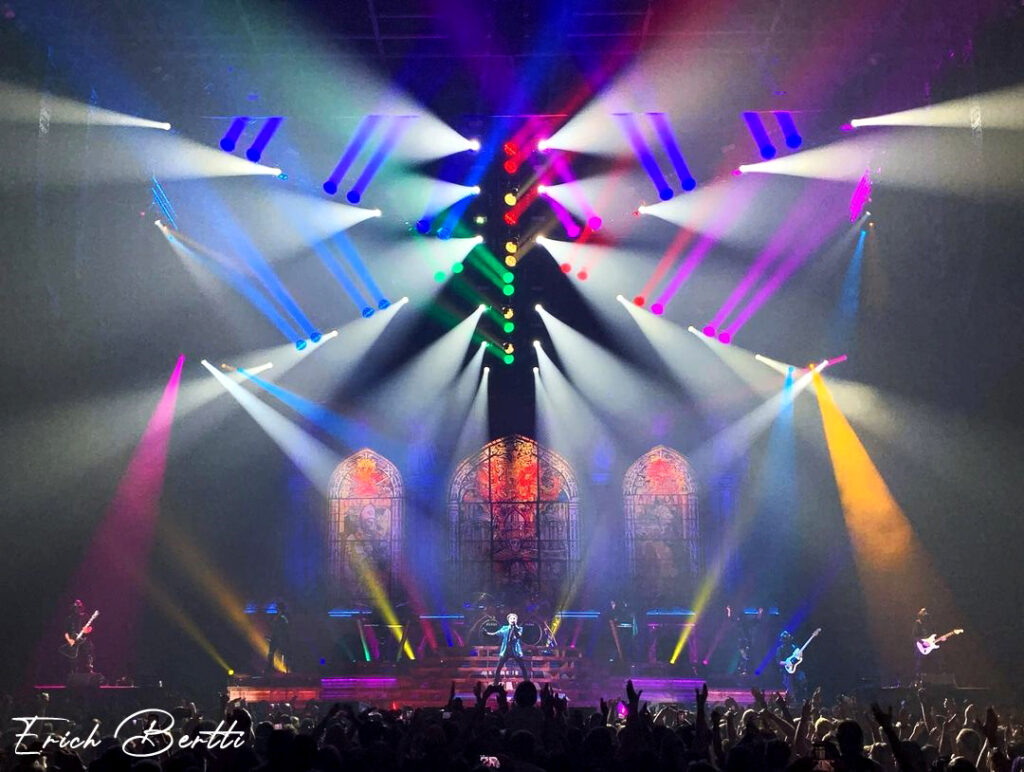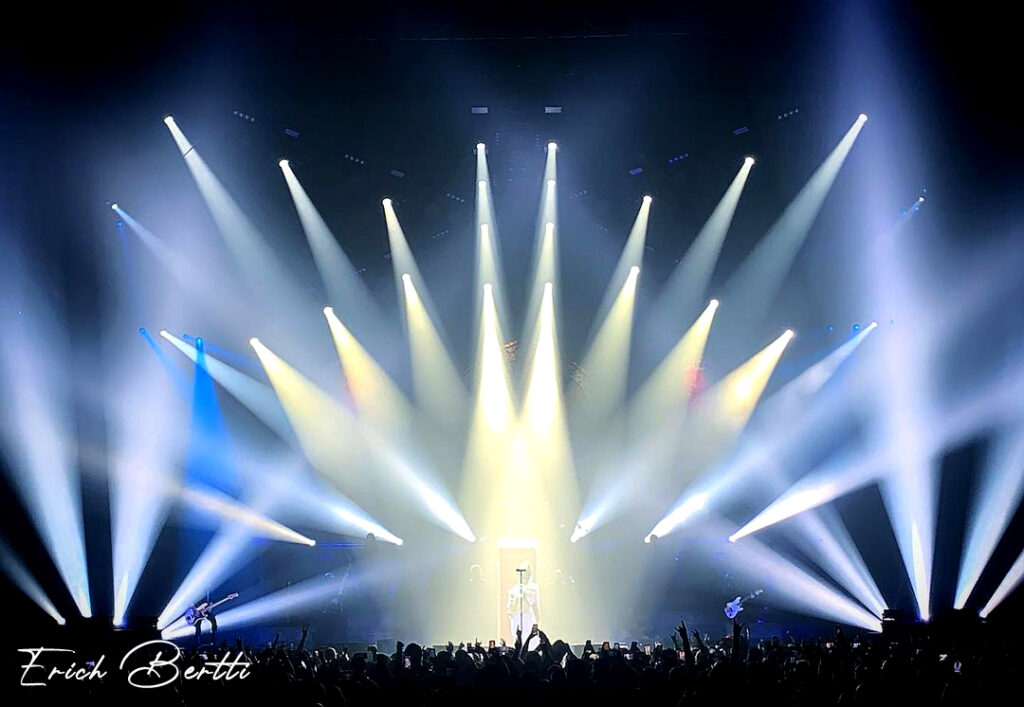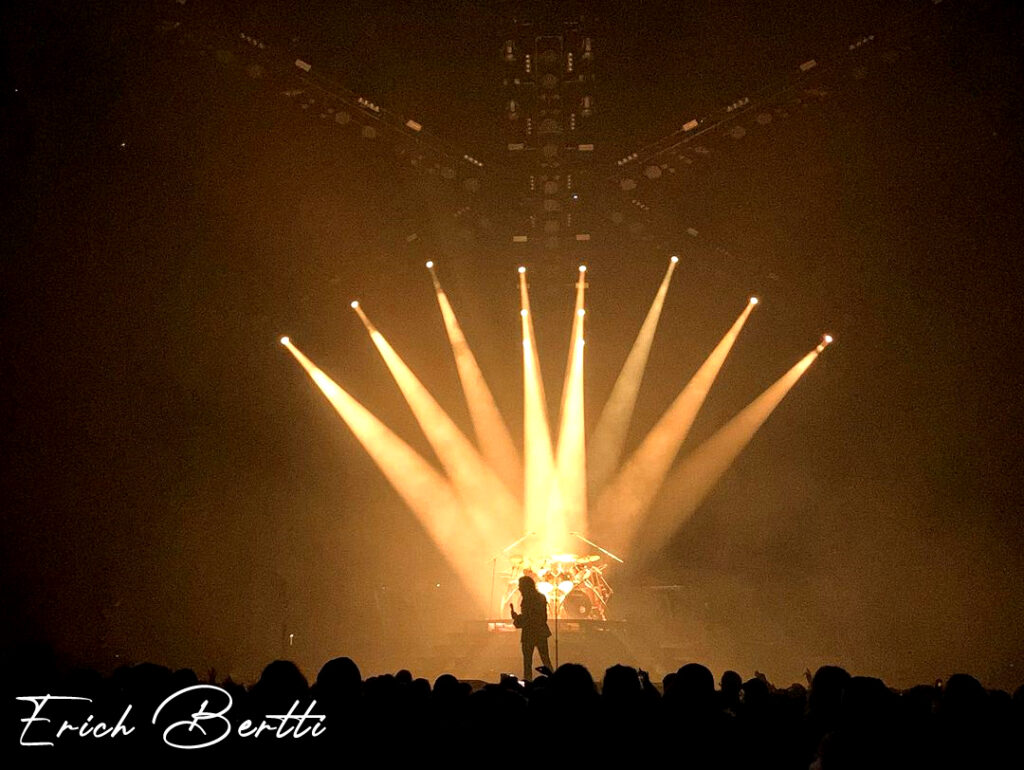The spectacular light effects at Ghost’s rituals – how Erich Bertti illuminates the show for us.

Lighting effects make a concert an unforgettable experience. Nevertheless, I don’t think it gets the attention and recognition it deserves. That’s why I would like to introduce the fans to the work of a lighting designer.
Erich, thank you for agreeing to answer a few questions about your very exciting work. Especially about your cooperation with GHOST. But please have mercy on us and try to explain it in a non-expert way. 🙂
First of all, I would like to know why you chose this profession? What attracted you to it? How do you become a lighting designer and what qualifications do you need?
Funny enough I’d say this profession chose me! And actually, I believe this is a profession you’re either born to do or not.
I sense that everyone in the show business has this series of characteristics that make them “viable” for the road life or not. The history behind my own journey begins with my uncle who is founder of one of the oldest lighting companies in Latin America – LPL – which is still strong and acting on the industry. A big portion of my family works with entertainment and we all share the same background: started very young as a fun holiday gig one-off and ended up being a career.
My first experience with the lighting world was a summer beach festival at my hometown Santos in Brazil, where I “helped” the guys to put up the followspots on the front of house towers and setting up colors, power and adjustments. I was 10 years old at that time and my parents didn’t allow me to stay for the concert. My brothers did and one of them is currently one of the CEOs of the company.
To become a lighting designer, you can go many ways. This is a question I receive a lot and I’d say it all depends heavily on your environment and country you reside in. For example, in the US or UK you have education that can take you from the true basics up until console programming while in third world countries such as Brazil you really have to chase the knowledge by yourself and make it work regardless of the obstacles. If I had to say one qualification would be the “hunger for knowledge”, since technology in the industry is a non-stop evolution race you gotta keep learning and evolving with it.

Would you like to tell us for which bands you have already designed the light shows? Do you only design concerts or also other types of events?
If you’re truly a lighting designer you can’t remain in one niche for too long. I’ve worked my entire life into the many aspects of lighting exactly to always keep versatile and fresh on how to tackle different projects and necessities.
I’ve done bands like the kings of heavy rock Motörhead to the soul goddess Joss Stone. Events for e-Sports like Riot’s League of Legends Worlds in China to extreme sports X-Games at the Iguaçu Falls. Theater shows like the Shaolin Wheel of Life and Celtic Women.
Hundreds of corporatives events for the most vast list of clients you can imagine. From rapel air ballet on a skyscraper to TED Talks. I even lit the Pope once for the World Youth Day in Rio de Janeiro! As long as you’re busy you’re learning. Every setup is different, every job is unique.
How did you get in touch with Ghost and how long have you been accompanying them? Which tours have you been on?
Ghost was presented to me by my life long brother Eddie Rocha who was production manager and tour manager for Motörhead. We were touring together by the time Lemmy passed away and the whole crew went different paths once Motorhead ended.
Rocha ended up on the Ghost team and after one tour they started having problems in the lighting department. On that first contact I had just become parent for my second child and wasn’t really looking to go back on the road, a design offer came up and I passed it because of the timing.
Six months later they were having problems again and he really presented me that I’d be the final solution to their problems. I was back on the road for a small European run with Brazilian artist Seu Jorge and ended up having a day off in Stockholm. Call it fate or chance but Tobias was in town and we arranged a meeting. You can say all went well from that day on. I have been with the ghost family since late 2018.
Can you explain what work needs to be done in advance when a request comes from a potential client? How much time do you have to create a concept before the tour starts? How many specifications do you get? Do you get the setlist beforehand? How do you present the concept to the client to get the approval? I saw that you drew a stage plan. Coming from the construction industry myself, I find that very interesting.
As I said before “every setup is different, every job is unique”. You can imagine that to start with the relationship between client and LD is always human: psychological and emotional stressful. You have to understand the dreams, the goals, the expectations, the financial reality, the time window available… for every different job there will be exclusive troubleshooting and custom approach. I believe this is a growing pain every time but also a very rich opportunity to learn and acquire some priceless experience.
This is where people mistake that technical knowledge is all you need. You first need to understand the human behind the art to then be able to enhance it the best way possible. Lighting in my mind is always about complement, about sum, showing the qualities and details the artists really care about and making the final product the closest to their visual projection of it, being music, fashion, corporative or sports.

How difficult is it to balance the client’s wishes with the budget?
In today’s world I’d say this is the most difficult part. It is such an intricate and time-consuming game that I can’t even begin to describe. Maybe one day I’ll be part of a production that is absurdly resourceful but up until this day I haven’t.
How do you experience life on the road during a tour? What do you enjoy? What would you rather skip?
The best part for me is the brotherhood. Every person living the road life, side by side every day, is a special type of person. We all have to deal with our own personal problems back home and still deliver 100% every single day to put up a production in and out on time. I have learned since very young to cherish the ones that embrace that task with a smile on their faces and that always try to make the day the best possible.
It is never an easy day on the road. Ever. What I would rather skip is the part where you feel you’re missing out on your kids childhood and leaving your partner alone to deal with it all. The small stuff makes a gigantic difference in a child’s life and to understand that and still be truthful to what you do is no simple task. I’ll always have the utmost respect for the crew exactly because I know how it is to be truly alone in a time of need. I believe the show business needs shorter tours after the whole pandemic experience, although I don’t see it been a future reality.
What does a typical working day look like? When does your day start and how much time do you need to prepare everything for the concert in the evening? How big is your team and what are the different fields of tasks?
We go in early, coming from a bus ride from A town to B town. Starts with “walk n chalk” which is when the riggers (tour plus locals) mark the floor with the coordinates for the motors that will hold the whole lighting, video, audio and anything else that “flys on the rig”.
Trucks start to be unloaded and all structure starts to be built in a logical order. All departments work together and sometimes in a parallel. All that is flown goes up normally by lunch time, then set and all floor structure gets built and ready, backline comes in and all departments start the fine tuning, PAs get tunes, lights get presets updated, sfx tested, barricades in place and house lights to doors level.
When all is set normally is time to set opening bands in and doors open. The lighting team on this last tour we had 5 lighting techs and 1 tour rigger. One is a dimmer man, takes care of power, one is a crew chief that considers logistics and timing of the tasks, the others general lighting techs – aka the warriors haha.
Although the initial request was 7 lx and 2 riggers. Budget kills… it was a grind but we managed pretty well I’d say. Teams always go with the needs and difficulties of a design. I always take the “crew friendly” aspect of my designs very much in consideration, because it can look as beautiful as you imagine but if you’re not able to come in and out every night you’ll never make a profitable tour.

What equipment do you always bring with you on tour? Do you take everything with you or do you also rent equipment on location? How many trucks do you need for your equipment?
It always differs. Some full production tours take everything, some take only a floor package. Trucks and gear vary from 1 to tens to hundreds. I personally don’t have anything other than my laptop.
I envy the spot you have during concerts. You have the perfect view of the band and the fans. But you probably don’t have much time to enjoy it in a relaxed way. What exactly do your work processes look like during the concert? Are the processes automated and do you only intervene in emergencies or is everything controlled manually in order to be able to react immediately to any deviations?
The front of house (FOH) is where the magic really happens. When sound and lighting “engineers” make the adjustments to the venue (which always differ!) and its conditions/limitations.
[Note: “The engineers involved are normally positioned in a small sectioned-off area front-of-house, surrounded by the audience or at the edge of the audience area. From this position they have unobstructed listening and a clear view of the performance.”]
Some days are easier and others harder but never easy. If you’re really into making your show the best possible I always believe there’s “one more thing to do”. I normally push buttons updating my programs until doors – basically when someone kicks me out of the console.
If I have a support band of course they also need their time with the rig and I want people to have the best time possible touring with us so respect is the key.
But yeah, I’d say the process is basically 10 hours straight pushing buttons. I always bring notes from last night’s gig and make sure to check it all. A never-ending process in pursuit of perfection!
As for the processes every band, LD and occasion has its own necessities. You can go fully automated with a timecode track from beginning to end or a full hands-on busking show. It’s all about being comfortable and happy with how and what you’re doing. I personally love the freshness of making things manually.

How much time do you have to disassemble and stow everything after the concert?
It varies. I normally feel the FOH is the LD’s responsibility. Because those are your direct tools for the job, you gotta be really on top of every bit of gear that populates FOH, every circuit, every cable.
Other than that, it’s all about the crew because once the show is done you’re pretty exhausted from the adrenaline rush and long day you just had. But I’ve had my share of years of dismantling every single bolt of a gig after 16hrs days of work, it’s just something you kinda earn with time.
Are there any special features in Ghost’s light shows? Perhaps also special challenges?
Is there anything you are particularly proud of?
Yes, many. Ghost is a one of a kind spectacle. I believe what I am most proud of is that I was the one LD capable of understanding the vision of the artist and replicate it with the mix of my own perception of the songs. That mental/emotional link is something really cool when it happens and I gotta say it is the most special bond an LD and an artist can have.
How difficult is it to keep adapting the show to the various venues or arenas? Are changes possible at short call?
Somewhat difficult, it can be a pain in the ass not having trim or a bad followspots positioning but in the end of the day your mind needs to be fresh to understand “the kids will love it” no matter what. To do the absolute best you can with what you have is the key.

Ghost has been expanding the pyrotechnics during the shows over the last few years. Are you involved in that as well or is there a separate team that you have to coordinate with?
Pyro is something that comes from the artist himself. But yeah, from time to time I am called for a perspective about it and say my piece. I feel it is perfectly dosed, not too much and well timed.
Yes I agree to that. It is pretty cool and I enjoy it a lot during the shows!
You also accompanied Ghost on the tour with Metallica in Europe in summer 2019. To what extent does the lighting differ at an open-air concert in daylight and what are the possibilities?
It changes everything. On that tour in particular our option was to make a set that was a declaration of Ghost’s identity, exactly because the whole dramatic lighting would be out of the game.
Lighting cues on an open-air day show have to be considered more about the timing and how you want audience to relate to the song than anything else. I’d say timing is the main thing for shows like that.
The pandemic had a big impact on the whole world and concerts couldn’t take place for a long time. How did you cope with the Corona period? How did it feel when it could finally start again?
I went through depression. Hard. It took me months to get back on my feet and it was the most difficult thing I ever faced. Up until this day, with the help of therapy and friends I still struggle to get my life back to a good place in many perspectives.
Once the show business returned, I got back to touring but for me the whole experience changed a lot and I have a very different view of the industry now. It feels good to see it all back but I am not sure about the future at this point. Taking one day at a time and making the best out of it.

I am very sorry that the pandemic hit you so hard. It was really a very difficult time. But it’s great that you found support and you are now back on the road again.
How do you see the problematics of the energy crisis and the rising costs? Do you think it will have an impact on future shows?
Yes. This needs to be addressed and is no small matter. Although it is just easier to remain following the same recipe used for the past 100 years, with small changes that happened along the way, we need to try to diminish our carbon marks in these upcoming years.
The numbers behind the industry are gigantic and some acts like Coldplay already made it clear that there are ways of diminishing that negative impact. I am always looking for new fixtures that consume less, that can deliver what I want in a more environmentally friendly way.
If we all make a little change individually, I’m sure we can go a long way collectively.
Very well said. In the future, we must all move a little closer together in this world and support each other.
Thank you for talking to me and giving us a little insight into your really exciting work. 🙂
Thank you!

Here you can find Erich’s Instagram account for more amazing infos:
